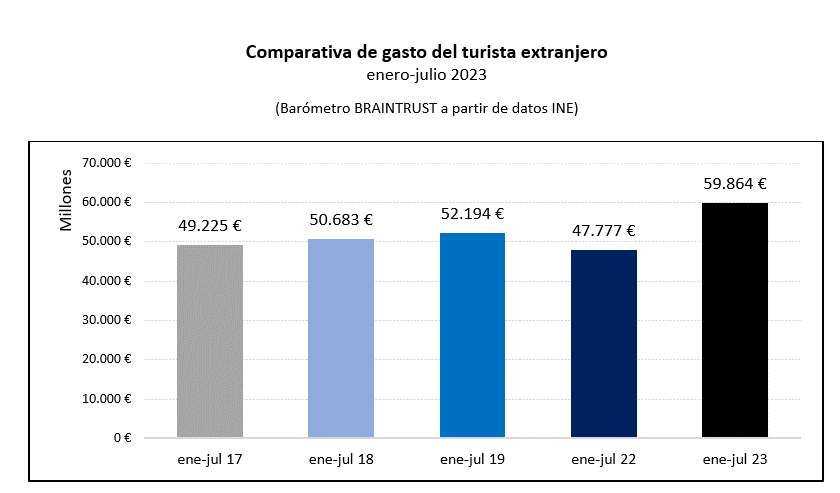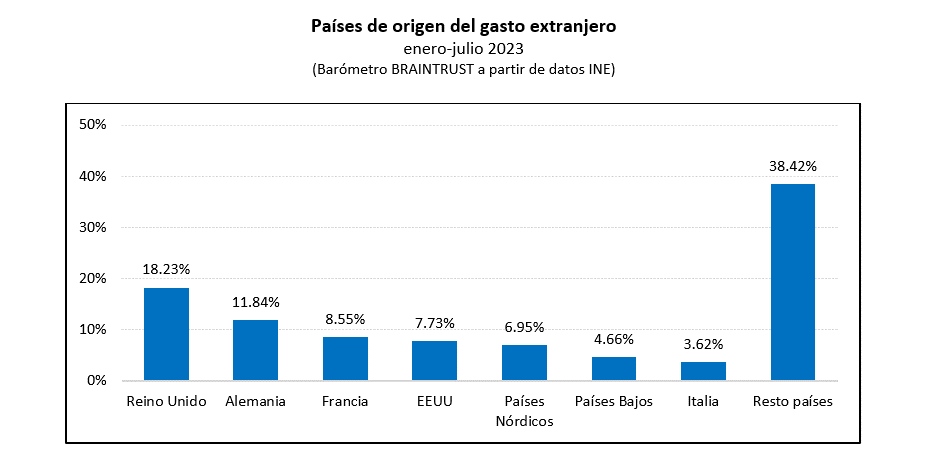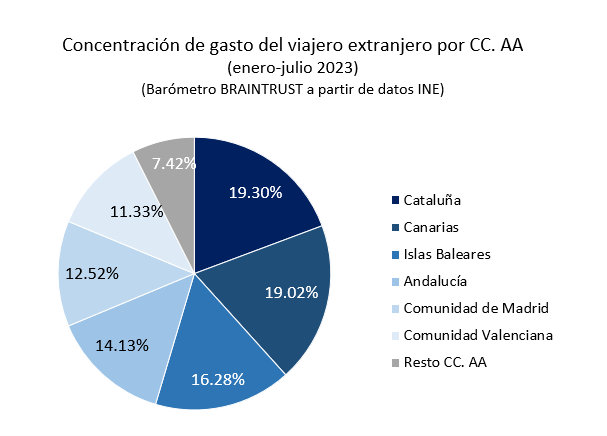Leading tourism consulting and professional services firm BRAINTRUST has issued a new industry analysis, in this case on foreign tourism spending through July, highlighting that the upward effect of the average foreign traveler's spending increase (+15.6%) equals price inflation in Spain (+15.9%), 2023 data compared to 2019.
Thus, BRAINTRUST's analysis shows that, although spending has shot up, the effect of inflation is the main reason for this increase.
In fact, the consultancy highlights that the number of trips falls by 0.77% through July compared to 2019, although the average stay rises from 6.97 nights in 2019 to 7.16 in 2023.
Rise in average spending equals inflation
BRAINTRUST delves into foreign travel spending by analyzing the changes demonstrated by consumers, comparing data through July 2023 versus 2019, the year before the pandemic.
Thus, the consulting firm states that the main reason for the increase in foreign tourism spending is not due to a greater influx of tourists from outside our borders, but mainly due to the rise in prices, whose increase according to INE data is 15.9% in July 2023 compared to July 2019.
The total spending figure would rise to 59,864 million euros from January to July this year, compared to 52,194 million euros in 2019, with an increase in total spending of 14.7% which contradicts some official speeches that this year will break spending records thanks to a higher quality tourist.

For Ángel García Butragueño, Co-Director of the Tourism Barometer, and Director of Tourism at BRAINTRUST: "The results are going to be another record year, but they hide behind a significant fact and that is that after the pandemic we have not improved the model, and only thanks to inflation, foreign tourism spending is up. I personally believe that there is much to do after the pandemic - where we all ventured to say that it would be a very useful period of reflection, and yet it seems that we have not learned anything - because the model suffers from the same precariousness as always, and is oriented to the number of tourists and not to their quality. Our industry once again continues to demonstrate its strength, generating 15% of employment in Spain and 12% of GDP, but that will not be enough in the coming years, when new travelers are looking for different destinations, with different models and diverse offers. There is no time to lose if we want to remain leaders in sustainable tourism in its broadest sense of the word in the future."
Average length of stay increases from 6.97 to 7.16 nights, a 2.69% increase
To get more out of the data, BRAINTRUST, also investigates howthe average stay has changed, which according to data provided by the consultancy has risen by only 2.69%, from 6.97 nights in 2019, prior to the pandemic, to 7.16 nights from January to July this year.
Going even deeper into detail, BRAINTRUST shows that the largest outbound market, the United Kingdom, decreased in average stay by 5.86%, while Germany increased by 3.60%, France by 2.35% and the United States, already the fourth largest outbound market by expenditure, increased by 8.87%.
By destination communities, there are some important differences, with Catalonia decreasing in average stay by 0.87%, Balearic Islands falls to 3%, Andalusia suffers a decrease of 0.47%, while the Canary Islands experiences a slight increase of 0.09%, the Valencian Community rises by 4.08%, leaving the leadership to Madrid whose average stay increases by 15.79% from 5.10 nights in 2019 to 5.90 nights average stay in 2023.
The 4 major markets, the United Kingdom, Germany, France and the United States, account for almost 50% of foreign spending.
According to the results of the consultant's analysis, the major markets continue to be the traditional ones, with the United Kingdom leading with 18.23% of total foreign spending up to July, followed by Germany with 11.84%, France with 8.55% and the United States in fourth place with 7.73% of the total.
The Nordic countries follow with 6.95%, the Netherlands with 4.66% and Italy with 3.62%.

The 6 main ACs account for 92% of revenues, with a high concentration in mature destinations. The 6 main regions account for 92% of revenues, with a high concentration in mature destinations.
As for the regions that received the most foreign tourists in the first seven months of the year, once again the six main Autonomous Communities were the ones that absorbed almost all foreign spending, with 92.58%. Once again, the six main Autonomous Communities absorbed almost all of the foreign expenditure with 92.58%, demonstrating once again the concentration of this tourism in Spain, leaving an insignificant 7.42% for the remaining 11 communities.
Thus, Catalonia once again leads the ranking with 11.55 million in revenues from January to July, with the Canary Islands close on its heels with 11.39 million, the Balearic Islands with 9.74 million, Andalusia with 8.46 million, Madrid with 7.49 million and the Valencian Community with 6.78 million.
They would be followed at a great distance by the Basque Country with 1.16 million, Galicia with 1.04 million and Murcia with 0.62 million.
This once again points to the need to deconcentrate foreign tourism spending with more effective campaigns in less visited regions.

For José Manuel Brell, Partner in charge of the Quantitative Studies and Models practice, and of the Tourism and Leisure Industry at BRAINTRUST: "Once again our analysis shows that we need to analyze the data in detail to know what is happening in our tourism, avoiding the easy discourse, and showing the strengths of our industry, but also the areas for improvement. There is a huge way to improve our sector, which years after the pandemic continues to show its strength with another expected record year, but where there are important gaps such as the dependence on volume and its concentration, in a mass-oriented model in which it seems that we are still immersed without being able to get out of the loop. We will see if the year 2023, beyond the number of tourists, shows that we have acted with a medium and long-term vision. In fact, the PSTD (Tourism Sustainability Plans in Destinations) should address these shortcomings with a greater and better positioning of the less mature destinations, so we will have to analyze the results once they are implemented. Once again, the data is not good if it is not analyzed with a business vision".






